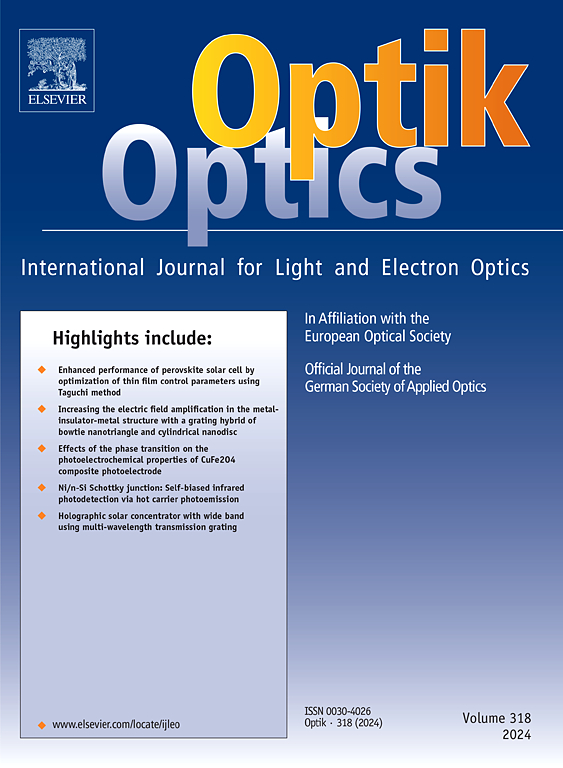Controlled hybridization of gaas-based vertically coupled hybrid plasmonic waveguide for low-loss nanoscale optical confinement
IF 3.1
3区 物理与天体物理
Q2 Engineering
引用次数: 0
Abstract
Plasmonic waveguiding stands at the forefront of nanophotonic innovation, offering immense potential for the development of compact and efficient nanophotonic devices. Despite its promise, this field has faced challenges, particularly in managing significant propagation losses that hinder device performance and efficiency. Addressing this critical barrier, we present an engineered GaAs-based vertically coupled hybrid plasmonic waveguide (VCHPW) that leverages controlled hybridization to achieve ultra-low-loss nanoscale optical confinement. Our innovative vertical coupling design enhances the interaction between plasmonic and dielectric layers, leading to superior mode confinement and substantially reduced propagation losses. The state-of-the-art design achieves remarkable performance, with ultra-low propagation losses of 0.004 dB/μm over a propagation length of 790 μm at a wavelength of 1.35 μm, and 0.0007 dB/μm over a propagation length of 5330 μm at a wavelength of 1.65 μm. Furthermore, the device exhibits a figure of merit ranging from 2280 to 5700. In comparison to conventional GaAs-based hybrid plasmonic waveguides, our proposed device demonstrates a reduction in loss by a factor of over 100. Additionally, it shows a significantly enhanced figure of merit and extended propagation length, marking an advancement in plasmonic waveguide performance. This meticulous engineering ensures that our VCHPW not only surpasses traditional hybrid plasmonic waveguides in terms of efficiency and confinement but also offers scalability and integration potential. These attributes are essential for future high-performance nanophotonic systems for communication and sensing technologies.
用于低损耗纳米级光约束的气基垂直耦合杂化等离子体波导的受控杂化
等离子波导站在纳米光子创新的前沿,为开发紧凑高效的纳米光子器件提供了巨大的潜力。尽管前景光明,但该领域仍面临挑战,特别是在管理影响设备性能和效率的显著传播损耗方面。为了解决这一关键障碍,我们提出了一种基于砷化镓的垂直耦合混合等离子体波导(VCHPW),该波导利用可控杂交来实现超低损耗的纳米级光学约束。我们创新的垂直耦合设计增强了等离子体层和介电层之间的相互作用,从而实现了优越的模式约束并大大降低了传播损耗。在1.35 μm波长下,在790 μm波长下,传输损耗为0.004 dB/μm;在1.65 μm波长下,在5330 μm波长下,传输损耗为0.0007 dB/μm。此外,该器件显示出从2280到5700的优点值。与传统的基于gaas的混合等离子体波导相比,我们提出的器件显示损耗减少了100多倍。此外,它还显示出显著增强的优点图和延长的传播长度,标志着等离子体波导性能的进步。这种细致的工程确保了我们的VCHPW不仅在效率和约束方面超越传统的混合等离子体波导,而且还具有可扩展性和集成潜力。这些特性对于未来用于通信和传感技术的高性能纳米光子系统至关重要。
本文章由计算机程序翻译,如有差异,请以英文原文为准。
求助全文
约1分钟内获得全文
求助全文
来源期刊

Optik
物理-光学
CiteScore
6.90
自引率
12.90%
发文量
1471
审稿时长
46 days
期刊介绍:
Optik publishes articles on all subjects related to light and electron optics and offers a survey on the state of research and technical development within the following fields:
Optics:
-Optics design, geometrical and beam optics, wave optics-
Optical and micro-optical components, diffractive optics, devices and systems-
Photoelectric and optoelectronic devices-
Optical properties of materials, nonlinear optics, wave propagation and transmission in homogeneous and inhomogeneous materials-
Information optics, image formation and processing, holographic techniques, microscopes and spectrometer techniques, and image analysis-
Optical testing and measuring techniques-
Optical communication and computing-
Physiological optics-
As well as other related topics.
 求助内容:
求助内容: 应助结果提醒方式:
应助结果提醒方式:


